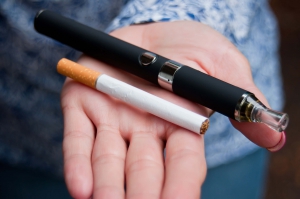A recent discussion with students in one of my classes focused on whether you can get “popcorn lung” from vaping.
I have to admit that I did not have a lot of insight on this subject. So I decided to do some research if vaping can cause popcorn lung.
First, let’s define popcorn lung
Let’s start with a little background on the odd clinical term “popcorn lung.”
Remember when microwave popcorn first came out with all of its delicious, buttery goodness? Despite the fact it was a tasty topping, the popcorn contained an ingredient called diacetyl.
While we were all on our couches watching movies and munching on bags of movie theater butter-flavored popcorn, workers being exposed to high levels of diacetyl in factories that produced the popcorn were experiencing respiratory complications.
Later dubbed “popcorn lung” for its affiliation with the snack, exposure to diacetyl during popcornmanufacturing caused their condition. The respiratory complications workers experienced were very similar to COPD.
This makes sense because diacetyl — when inhaled in large quantities and over a period of time — apparently damaged the alveoli, causing them to become thickened and scarred, a term known as bronchial obliterates because it literally “obliterates” the alveoli. This condition renders the alveoli ineffective, similar to the effects of COPD.
The good news, however. Most popcorn manufacturers did away with the harmful ingredient after workers in Missouri were discovered to have the condition. The workers had been exposed to the butter flavoring ingredient over a long period of time. In fact, they had not even attributed their respiratory difficulties to the workplace because the symptoms had developed slowly.
A physician who treated them all separately eventually linked their similar conditions to the chronic exposure of diacetyl in the plant where they all worked. The effects of their conditions required several workers to eventually have lung transplants, as bronchial obliterates are irreversible. Again, just like COPD.
Vaping becomes trendy and socially acceptable
Fast forward to the invention of the e-cigarette. Hailed as a safer alternative to smoking, e-cigarettes have become the rave. You can find vape stores in just about every city and town across North America.
While it is certainly much more pleasant to walk by someone puffing on fruit-flavored e-juice than a traditional cigarette, it is not uncommon to have to work your way through a cloud of the exhaled product. This picture has become a common scene in many downtown areas outside of vape shops.
Entering a vape store is like diving into a smorgasbord of flavors, ranging from your basic tobacco to something you would expect to see on the cover of a pint of Ben and Jerry’s.
Touted as a safe alternative to smoking, vaping is becoming popular for a growing number of teens and young adults. They may easily lay down a couple hundred dollars on a high-quality vape pen and some flavored e-juice.
The harmful risks and unpleasant odor of traditional smoking compared to that of vaping are pretty indisputable. Gone are the days of the lingering stench of cigarettes on clothes and the waft of ashtray that follows a person into a room after they have been outside smoking cigarettes.
Sounds great, right? Maybe not so much. While some have hailed vaping as a safer and more socially acceptable alternative, there are still concerns regarding the ingredients in the e-juice.
Do you know which ingredients are in e-cigarettes?
It is important to note that the FDA has not required e-cigarette producers to provide a list of ingredients for evaluation. More importantly, they don’t anticipate this requirement until 2022. That basically means that, as of now, there are no true regulations on the ingredients.
In the UK, diacetyl has already been banned in e-juice, indicating the concern for long-term exposure is a legit one.
In a 2015 study, Harvard University discovered 39 of 51 e-cigarette brands contained diacetyl. Sound familiar? That is the same ingredient found in the butter flavoring of microwave popcorn. It is the same ingredient responsible for giving workers bronchial obliterates, also known as popcorn lung.
In addition to diacetyl, researchers discovered the presence of 2,3-pentanedone and acetoin, which are two other harmful chemicals. Harvard concluded in its study that 92% of e-cigarettes tested contained one or more of those three harmful ingredients.
While there is yet to be a known case of popcorn lung as a result of e-cigarette smoking, there is a strong indicator that vaping e-juice containing these ingredients could lead to the condition over time.
In the meantime, we should be aware of the correlation between the harmful ingredients in some e-juice products and the past workplace exposure resulting in lung disease. We should also remember that although you can get e-juice without nicotine, it is typically a component of the product. We know that nicotine carries a great deal of its own risks to the human body.
Is vaping better than cigarettes?
Though vaping remains a safer alternative to traditional smoking, some studies say it still comes down to the issue of inhaling harmful chemicals. I have seen people who smoked for years quit by using a vape pen — and I commend them for doing it.
For those people who used vaping as a bridge to quitting smoking, they have likely done themselves a great service in the long run. For the folks who traded one habit for another, I question the long-term effects vaping will have on them, and whether in the end it will be much better than smoking.
We likely won’t have the necessary data for years to know how harmful e-cigarettes really are and if vaping causes popcorn lung. It takes years to begin to witness the effects of continued exposures and to correlate those findings.
Is vaping better than smoking and can vaping cause popcorn lung? It’s probable, but we will have to wait to find out.

